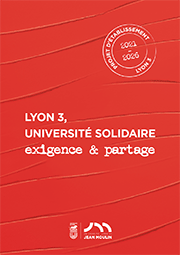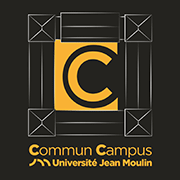AccueilRechercheProgrammes et productions scientifiquesThèsesThèses soutenuesThèses soutenues - 2022
-
Partager cette page
- Recherche,
- Philosophie,
MALLET Renaud
Humanitas et vie phénoménologique absolue. L'être humain dans la philosophie de Michel Henry
Publié le 12 janvier 2023 – Mis à jour le 9 avril 2024
Thèse en Philosophie, soutenue le 24 octobre 2022.
Dans quelle mesure peut-on développer à partir de l’ontologie henryenne une anthropologie philosophique ? Le concept d’humanitas se présente dans l’?uvre de Michel Henry comme un concept déterminant, quoique insuffisamment déterminé ; de sorte que cette ?uvre se trouve motivée et structurée en chacun de ses moments par une anthropologie potentielle. En épurant, en ordonnant, et en explicitant, ce qui s’initie et se développe progressivement dans le corpus henryen, cette thèse se propose de rejoindre – i.e. de répéter et de prolonger – le mouvement d’actualisation du potentiel théorique qui se concentre dans la formule : ? l’homme est un vivant dans la Vie ?. A l’aune du concept de vie phénoménologique absolue, elle vise à accomplir une genèse transcendantale de notre humanitas en deux moments. Une première partie, étayée sur le thème de la duplicité de l’appara?tre, cherche à tracer et à définir, en de?à du plan empirico-transcendantal à la surface duquel le monisme ontologique situe l’être humain, le plan radicalement immanent où se déploient les déterminations premières et fondamentales du concept henryen d’humanitas – plan invisible dont les coordonnées principales sont la réalité, la phénoménalité, l’affectivité, et l’ipséité. Elle revient à se demander ce que signifie être vivant pour l’être humain, s’il est vrai que la vie se définit comme auto-affection. La seconde partie, se mouvant sur le plan ainsi pré-tracé et pré-défini, et s’appuyant alors sur les thèmes de la Corpspropriation et de l’In-carnation, s’emploie à décrire un ensemble de déterminations secondaires et spécifiques qui assurent une délimitation plus précise du concept d’humanitas. Elle s’efforce de dire ce que signifie être humain pour un vivant, s’il est vrai qu’en l’homme la vie s’auto-affecte d’une manière particulière. A la faveur de ce progrès, la description initiale de notre humanité, essentiellement centrée sur la relation immédiate et pathétique définissant un soi et la substance charnelle d’une auto-affection, peut alors s’enrichir d’une prise en compte expresse de la relation au monde et à Dieu permettant de spécifier le soi propre à l’homme, la modalité humaine de la chair et de son auto-affection. Si le premier moment repose sur une radicalisation du transcendantal, le second est guidé par sa modalisation. La définition phénoménologique de l’être humain comme être-en-vie trouve ainsi les conditions de son affinement dans la caractérisation de celui-ci comme vivant-au-monde et vivant-fini-dans-la-Vie : d’une part la mise en avant d’un complexe de pouvoirs particuliers déterminant son Je peux – la sensibilité, la motricité, la psychéité et la créativité – sert une caractérisation progressive de l’être humain au sein de l’ensemble des vivants finis ; d’autre part l’élucidation d’un non-pouvoir radical affectant ce Je peux – sa nativité – permet sa différenciation d’avec la Vie infinie. De sorte que la perspective ontologique uni-dimensionnelle, rabattant l’être de l’homme sur le seul plan de l’essence vitale immanente, trouve à se déployer et à s’approfondir en une approche multi-dimensionnelle plus proprement anthropologique, mettant en évidence, dans l’immanence de la chair du vivant humain, un ensemble de strates architectoniques d’existence (ses dimensions naturelle, organique, symbolique, spirituelle, religieuse, intersubjective, morale). Ainsi, au prisme d’une double épreuve : l’épreuve pour l’anthropologie d’une problématique ontologique radicale fondée sur un acosmisme décrivant l’essence pure de la vie absolue, et l’épreuve pour cette ontologie d’un questionnement anthropologique précis obligeant à prendre en compte le caractère le plus concret de l’existence humaine, se dégage une conception consistante de notre humanité en laquelle se noue une relation étroite entre un (certain) réalisme et un (certain) humanisme, dessinant la figure singulière de ce qui n’a pas encore de nom et qui pourrait peut-être recevoir celui d’archihumanisme.
Mots-clés : anthropologie philosophique/ philosophie de la vie /phénoménologie matérielle/ duplicité de l'appara?tre/immanence acosmique/monisme ontologique/ doublet empirico-transcendantal/auto-affection/soi charnel/excédence/passivité/ ? Je peux ?/corpspropriation/vivant-au-monde/sensori-motricité/effort/ incarnation/Fils de Dieu /finitude/archihumanisme
To what extent can a philosophical anthropology be developed from Henry's ontology? The concept of humanitas appears in Michel Henry's work as a determining, though insufficiently determined, concept, so that this work is motivated and structured in each of its stages by a potential anthropology. By purifying, ordering, and making explicit what is initiated and progressively developed in the Henry corpus, this thesis proposes to join - i.e., to repeat and extend - the movement of actualisation of the theoretical potential that is concentrated in the phrase "man is a living being in Life". In the light of the concept of absolute phenomenological life, it aims to accomplish a transcendental genesis of our humanitas in two stages. The first one, based on the theme of the duplicity of appearing, seeks to trace and define, below the empirical-transcendental plane on the surface of which the ontological monism situates the human being, the radically immanent plane on which the primary and fundamental determinations of the Henryian concept of humanitas unfold - an invisible plane whose main coordinates are reality, phenomenality, affectivity, and ipseity. It amounts to asking what it means to be alive for the human being, if it is true that life is defined as self-affection. The second part, unfolding on the plane thus pre-traced and pre-defined, and basing on the theme of the Corpspropriation and of the In-carnation, then sets out to describe the set of secondary and specific determinations, which, against the background of the former, map out the concept of humanitas more precisely. It endeavours to specify what it means to be human for a living being, if it is true that in man life is self-affecting in a particular way. Thanks to this progress, the initial description of our humanity, essentially centred on the immediate and pathetic relation defining a self and the fleshly substance of self-affection, can then be enhanced by an express consideration of the relation to the world and to God making it possible to specify the self that is proper to the human being, the human modality of the flesh and its self-affection. While the first part rests on a radicalisation of the transcendental, the second part is guided by its modalisation. The phenomenological definition of the human being as being-in-life can thus be refined through the characterisation of the latter as living-in-the-world and finite-living-in-Life: On the one hand, the highlighting of a set of particular powers determining his “I can” - sensitivity, motricity, psycheity and creativity - serves a progressive characterisation of the human being within the whole of the finite living, and, on the other hand, the elucidation of a radical non-power affecting this “I can” - his nativity - allows him to differ from the infinite Life. In this way, the uni-dimensional ontological perspective, which reduces man's being to the sole plane of immanent vital essence, finds itself deployed and deepened in a more properly anthropological multi-dimensional approach, highlighting, in the immanence of the flesh of the living human being, a set of architectonic layers of existence (its natural, organic, symbolic, spiritual, religious, intersubjective and moral dimensions). Thus, through the prism of a double test - the test for anthropology of a radical ontological problematic based on a form of acosmism describing the pure essence of absolute life, and the test for this ontology of a specific anthropological questioning making it necessary to take into account the most concrete character of human existence - a consistent conception of our humanity emerges, in which a close relationship between a (certain) form of realism and a (certain) form of humanism is established, drawing the singular figure of what has not yet been named and which might possibly be given the name of archi-humanism.
Keywords : philosophical anthropology / philosophy of life/material phenomenology/ duplicity of appearing/ acosmic immanence/ ontological monism / empirical-transcendental doublet/self-affection/ fleshly self/ excess/ passivity / ? I can ?/ corpspropriation/ living-in-the-world/ Sensory-motricity/effort/ incarnation/Son of God/finiteness/archi-humanism
Directeur de thèse : Etienne BIMBENET
Membres du jury :
- Mr BIMBENET Etienne, Directeur de thèse, Professeur des universités, Université Jean Moulin, Lyon 3,
- Mr JEAN Grégori, Rapporteur, Professeur des universités, Université jean Moulin Lyon 3,
- Mr LAVIGNE Jean-Fran?ois, Rapporteur, Professeur des universités, Université Jean Moulin Lyon 3,
- Mr AUDI Paul, Chercheur PHILEPOL, Université Sorbonne Paris Descartes,
- Mme DEVARIEUX Anne, Ma?tre de conférence habilitée à diriger des recherches, Université de Caen,
- Mme LORELLE Paula, Chercheuse, Université Catholique de Louvain, Archives de Husserl, Paris.
- Mr JEAN Grégori, Rapporteur, Professeur des universités, Université jean Moulin Lyon 3,
- Mr LAVIGNE Jean-Fran?ois, Rapporteur, Professeur des universités, Université Jean Moulin Lyon 3,
- Mr AUDI Paul, Chercheur PHILEPOL, Université Sorbonne Paris Descartes,
- Mme DEVARIEUX Anne, Ma?tre de conférence habilitée à diriger des recherches, Université de Caen,
- Mme LORELLE Paula, Chercheuse, Université Catholique de Louvain, Archives de Husserl, Paris.
Président du jury : Grégori JEAN
Documentation
Mise à jour : 9 avril 2024






